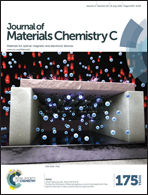Selective colorimetric detection of Cu2+ by lanthanide based hybrid complexes associated with a single crystal growth mediated transformation†
Abstract
Two rare earth (Dy3+ and Nd3+) based complexes were synthesized using the ligands bipyridine, p-amino benzoic acid and nitro benzoic acid. The complexes were characterized by single crystal and powder XRD, IR spectroscopy and thermogravimetric analysis. Both complexes showed characteristic luminescence properties of the lanthanides and weak metamagnetic transitions at low temperature. Both the Dy and Nd compounds were found to detect Cu2+ selectively in very low concentrations of the transition metal salt in the mixture of other transition metals like Cu2+, Co2+, Ni2+, Zn2+, Cd2+, Ag+ and Au3+. This selective copper uptake is associated with a fast distinct colour change as a result of which the detection of copper can be realized visually. The Nd compound was more selective and detected Cu2+ selectively till 10−5 M concentration of the Cu salt. The Cu2+ encapsulation in the Nd complex was characterized through a rare single crystal growth mediated transformation involving an irreversible exchange of the metal ion of the complex. This single crystal transformation facilitates the easy understanding of the copper encapsulation mechanism and also provides information on the detector complex, which is rarely studied.


 Please wait while we load your content...
Please wait while we load your content...